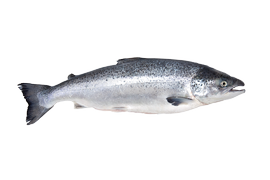
SALMON
A fully grown salmon has shining silver sides, a grey green back and white belly and – if we’re being pedantic – comes from the North Atlantic. Salmon has played an important historical role in Scandinavian cuisine, which is why this part of the world has so many recipes for cooking and preserving it.
Fish facts
Wild salmon migrates between fresh and salt water during its lifetime. When and where it is caught has a major impact on its appearance, flesh and flavor. Farmed salmon are most common on the fish counter.
Salmon is a healthy food that contains a high amount of Omega 3 fatty acids and is rich in vitamins A and D. Due to its high unsaturated fat content, salmon needs to be stored correctly.
Studies have shown that some children view “salmon” as a separate category to “fish”. This makes salmon an ideal way of persuading children to eat and appreciate fish.
Many professionals think salmon is too fatty for a fine stock/bouillon.
How to cook salmon
The general rule is that a bigger salmon has more flavor than a smaller one.
In fresh salmon, the front part of the fillet has 25 to 30 small pin bones. Run your finger over the flesh to find them and pull them out with a sharp pair of tweezers. The fresher the salmon, the harder they are to remove.
Deep frozen salmon portions are practical but unfortunately the taste is not as good as fresh. Buying a whole, fresh side of salmon and cutting it up yourself produces a considerably better result.
Salmon is possibly the easiest fish to combine with other flavors. Egg, dill, spinach, horseradish, soy sauce or tandoori – it’s all good. Sharp, acidic flavors go well with the fatty, flavorsome flesh.
It’s a good idea to rub salmon fillets with salt about 20 minutes before frying. Fry the flesh side first on fillets with skin. Use an accurate thermometer with a thin probe and cook to 48°C – 52°C.
Cold poached salmon tastes better (but looks paler) with a little vinegar in the water.
The risk of parasites mainly affects wild salmon, not farmed. According to new recommendations, farmed salmon does not need to be frozen before making sushi or ceviche.
Pieces of salmon for sashimi and sushi should be cut against the fibers of the flesh.
The classic
There is so much that you can do with salmon but here’s something you might not have tried – a traditional Swedish classic is salmon pudding, made from salted salmon with melted butter. 8You can find the recipe on the Internet or through a well known Swedish furniture store.)
Conservation status:
Organic and MSC labelled salmon is green. Other farmed salmon is yellow or red due to high environmental impact.








